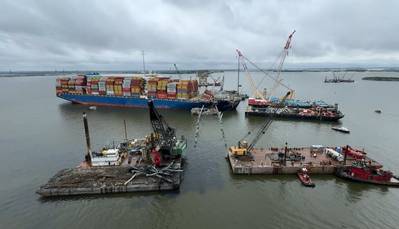Video: Wreckage Removal Needed Before Dali Refloat
Unified Command officials continue to evaluate the M/V Dali in preparation for refloating the vessel and clearing the channel.
Officials have evaluated sonar and lidar imagery but are awaiting results from a dive survey before proceeding with plans to refloat and move the Dali to Seagirt Marine Terminal in the Port of Baltimore.
The diver inspection is a necessary step in the complicated process of reopening the Fort McHenry Federal Channel in a manner that mitigates risk to the vessel once it’s carefully refloated and moved from its current position.
To permit safe diver access to the Patapsco riverbed next to the vessel, Unified Command cranes must first remove submerged and unstable wreckage from the controlled demolition. Safety also dictates the securing or removal of severely damaged containers and overhanging wreckage from the initial bridge collapse onto the deck of the Dali. This process is already underway.
In the early morning of March 26, the Dali lost power and crashed into a bridge support, sending the span into the Patapsco River, with a major portion draped over the Dali's bow. Six construction workers were killed.
More than 365 vessels have since transited four temporary channels opened, the first of which was opened six days after the March 26 bridge collapse. These transits for commercial and recreational vessels will continue during the ongoing process to refloat the Dali and salvage operation to clear the federal channel.
Nearly 50% of the 700-foot-wide Fort McHenry Federal Channel had already been cleared to an operational depth of 48 feet before the controlled demolition. The federal channel is expected to be fully capable of supporting all commercial vessels in and out of the Port of Baltimore to a minimum operational depth of 50 feet in the weeks ahead.














